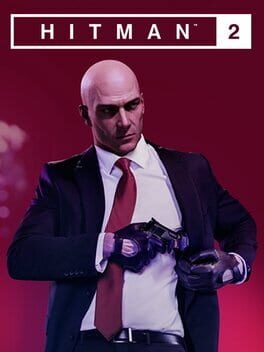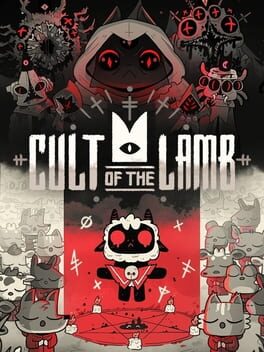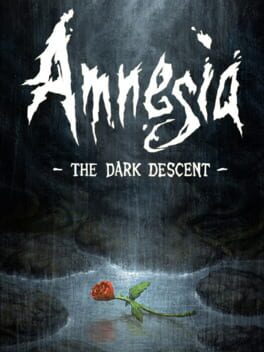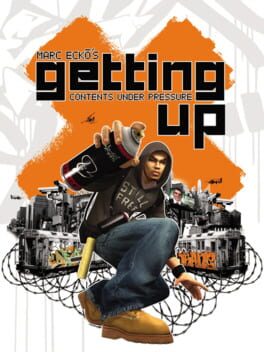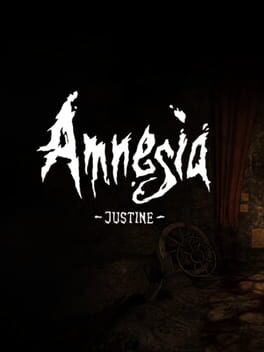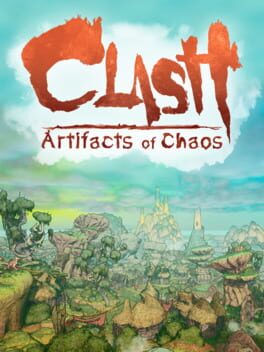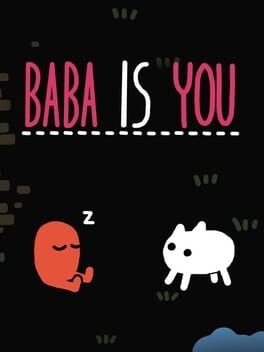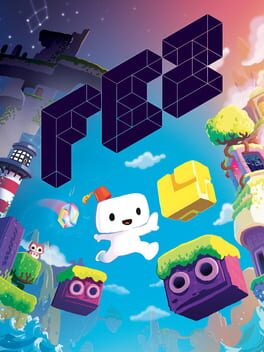waywardlaser
482 reviews liked by waywardlaser
Hitman 2
2018
Cult of the Lamb
2022
So, I've done research. This is what they do: number one, you can see a cultist here, and the other cultist is poo-pooing, and this cultist is eating the poo-poo all over the place. Tell me, when you have a chosen one crusading in the name of The One Who Waits, do you say accept eating poo-poo?
As followers of the Four Bishops, we want to ask The Lamb to explain to us, is this what they want to bring to the Lands of the Old Faith? As an animal right to eat the poo-poo of our children?
As followers of the Four Bishops, we want to ask The Lamb to explain to us, is this what they want to bring to the Lands of the Old Faith? As an animal right to eat the poo-poo of our children?
Persona 3 Reload
2024
Not too much to say about Persona 3 Reload, it's just a very solid remake of a classic RPG. The quality of life improvements and balance changes, in addition to new mechanics such as Theurgies keep the gameplay fresh and interesting. There are a greater number of night time activities as well, which helps to stave of the repetitive nature of night time. While the plotting is pretty close to shot-for-shot remake in a lot of parts, what new additions did find their way into the game were pretty well done and felt organic enough. This does feed into my one criticism in that a lot of the script is just reused from the original game. There are several Social Links in the game that could use a rewrite and in general it's just kind of lame to not see certain aspects of the plot expanded upon or delved into in greater detail. Still a great game though, and definitely worth your time if you're a Persona fan.
Yakuza 0
2015
The game that launched a dozen millionaire YouTuber careers, helped usher the golden/cursed age of the let's play and marked a watershed moment in horror game design. Yet when The Dark Descent was busy being extolled as the scariest game evar I was that faint, squeaky "nuh-uh!" at the back of the congregation.
Despite being an avid fan of both horror and adventure games and, as a result, being an early fan of Frictional Games via the Penumbra series, I'd always been lukewarm on Amnesia and somewhat baffled by its monumental mainstream success. Besides not being scary (as I'd claim back then) it was just annoying to play through, with its sanity bar, incessant distortion effects, constant voiceover monologues that make you walk through molasses while listening, endless flashes to bright white in a game expected to be played in the dark, oil that burns out in 30 seconds and a character deathly allergic to any room with lighting below 2,000 lumens. I felt the horror gameplay was not only overly basic but bogged down with all this useless annoyance, as if they saw Far Cry 2’s infamous perpetually jamming guns and thought that’s what our whole game should be.
Well 14 years later, removed from the hype and coming off a newfound (or perhaps rediscovered) respect for this team off the back of SOMA and The Bunker I can see I was for the most part missing the forest for the trees on this. Those white screen flashes and molasses-walk voiceovers can still buzz off and the scripted distortions do drag on a bit now and then but mostly I was just too familiar with Penumbra and had grown bored with Frictional's tricks at precisely the same moment the internet got obsessed with them. With Penumbra now fading from my old man memory I can see now there’s a lot of good here that I'd been taking for granted.
A sanity bar still irks me a bit in principle because it feels like the game trying to tell me my own reaction, but not being able to look directly at enemies and mechanically making the player actually afraid of the dark itself are both genius, and having to balance two competing stats in trying not to go crazy and trying not to die adds a perceived weight to one's moment-to-moment decision making throughout. The lantern oil is particularly stingy at first but if you're even a little conservative you'll soon have more oil than you'll need, so that it's not annoying, yet very rarely have enough at once to feel comfortable. Not to mention trying in vain to keep a dwindling flame alive in the depths of darkness is a powerful visual motif in line with the sanity theme and the writing's Lovecraftian ambitions.
An organically induced fear of the dark and the management of light were near-perfected in last year's brilliant and relentlessly oppressive Amnesia: The Bunker, but we have to walk before we can run and The Dark Descent lays a solid groundwork before they were brave enough to really get sadistic on a gamer. Perhaps more notably it's Amnesia's first sequel, A Machine For Pigs, that made me rethink the light management most, in that one you can use your light indefinitely with no consequence and ironically that abundance makes it feel like something is sorely missing. In that game you never feel like you're in real danger, where here (and even far moreso in The Bunker) it never feels like you're really safe. For immersive horror that's nothing short of a triumph.
Most of all though I realize now that I was wrong about one thing above all else, and now I'm no longer too cool to admit the truth: The Dark Descent is scary. Hugging a wall, moving slowly through the dark, thinking you're really going to make it, hearing that music cue, making a break for it and frantically trying to open a door, close it again and block it on the other side is still some of the most exhilarating moments any game can offer. Frictional's beautifully wonky physics engine ensures that opening drawers never gets old and that doors will always max out your heart rate during a chase. When you're a bit fatigued with no-combat 'pursuer' enemy designs it's good to return to the masters and be reminded why it got so popular in the first place.
Puzzles mostly strike a good balance in turning your brain on enough to get the dopamine flowing without being likely to get you stuck (though I did once resort to the patented adventure game tradition of just trying every item on every other item - a jar on a string, of course, why didn't I think of that? Also that pipe wall puzzle was fucking stupid), the writing is pretty good throughout - enough to make me actually eager to be picking up another note - and the villain has possibly the most epic voice evar.
There's an abundance of muddy dungeon maze environments but somehow there's still enough variance and novelty in the puzzles and monster encounters to keep this descent compelling even 14 years, many sequels and countless imitators later. My return to Castle Brennenburg was a fruitful one beyond my expectations. It turns out sometimes it's not everyone else who was wrong, sometimes it just takes another 500 games in the log to begin to understand the genius you'd previously dismissed.
Despite being an avid fan of both horror and adventure games and, as a result, being an early fan of Frictional Games via the Penumbra series, I'd always been lukewarm on Amnesia and somewhat baffled by its monumental mainstream success. Besides not being scary (as I'd claim back then) it was just annoying to play through, with its sanity bar, incessant distortion effects, constant voiceover monologues that make you walk through molasses while listening, endless flashes to bright white in a game expected to be played in the dark, oil that burns out in 30 seconds and a character deathly allergic to any room with lighting below 2,000 lumens. I felt the horror gameplay was not only overly basic but bogged down with all this useless annoyance, as if they saw Far Cry 2’s infamous perpetually jamming guns and thought that’s what our whole game should be.
Well 14 years later, removed from the hype and coming off a newfound (or perhaps rediscovered) respect for this team off the back of SOMA and The Bunker I can see I was for the most part missing the forest for the trees on this. Those white screen flashes and molasses-walk voiceovers can still buzz off and the scripted distortions do drag on a bit now and then but mostly I was just too familiar with Penumbra and had grown bored with Frictional's tricks at precisely the same moment the internet got obsessed with them. With Penumbra now fading from my old man memory I can see now there’s a lot of good here that I'd been taking for granted.
A sanity bar still irks me a bit in principle because it feels like the game trying to tell me my own reaction, but not being able to look directly at enemies and mechanically making the player actually afraid of the dark itself are both genius, and having to balance two competing stats in trying not to go crazy and trying not to die adds a perceived weight to one's moment-to-moment decision making throughout. The lantern oil is particularly stingy at first but if you're even a little conservative you'll soon have more oil than you'll need, so that it's not annoying, yet very rarely have enough at once to feel comfortable. Not to mention trying in vain to keep a dwindling flame alive in the depths of darkness is a powerful visual motif in line with the sanity theme and the writing's Lovecraftian ambitions.
An organically induced fear of the dark and the management of light were near-perfected in last year's brilliant and relentlessly oppressive Amnesia: The Bunker, but we have to walk before we can run and The Dark Descent lays a solid groundwork before they were brave enough to really get sadistic on a gamer. Perhaps more notably it's Amnesia's first sequel, A Machine For Pigs, that made me rethink the light management most, in that one you can use your light indefinitely with no consequence and ironically that abundance makes it feel like something is sorely missing. In that game you never feel like you're in real danger, where here (and even far moreso in The Bunker) it never feels like you're really safe. For immersive horror that's nothing short of a triumph.
Most of all though I realize now that I was wrong about one thing above all else, and now I'm no longer too cool to admit the truth: The Dark Descent is scary. Hugging a wall, moving slowly through the dark, thinking you're really going to make it, hearing that music cue, making a break for it and frantically trying to open a door, close it again and block it on the other side is still some of the most exhilarating moments any game can offer. Frictional's beautifully wonky physics engine ensures that opening drawers never gets old and that doors will always max out your heart rate during a chase. When you're a bit fatigued with no-combat 'pursuer' enemy designs it's good to return to the masters and be reminded why it got so popular in the first place.
Puzzles mostly strike a good balance in turning your brain on enough to get the dopamine flowing without being likely to get you stuck (though I did once resort to the patented adventure game tradition of just trying every item on every other item - a jar on a string, of course, why didn't I think of that? Also that pipe wall puzzle was fucking stupid), the writing is pretty good throughout - enough to make me actually eager to be picking up another note - and the villain has possibly the most epic voice evar.
There's an abundance of muddy dungeon maze environments but somehow there's still enough variance and novelty in the puzzles and monster encounters to keep this descent compelling even 14 years, many sequels and countless imitators later. My return to Castle Brennenburg was a fruitful one beyond my expectations. It turns out sometimes it's not everyone else who was wrong, sometimes it just takes another 500 games in the log to begin to understand the genius you'd previously dismissed.
Scorn
2022
Scorn is an uneven balance of Riven-like alien techno-puzzling and atmospheric existential horror akin to SOMA. The art is a perfect amalgamation of Giger & Beksiński, fleshy organic architecture amassed across the surface of a dying world. The first two-thirds present particularly engaging core puzzles, as you slowly unpick the purpose of the machines you are revving up, often leading to some sort of sacrifice of an innocent(?) being (ranging from tiny weird guys to enormous weird guys) in this abject world. The wordless communication of the narrative through exploration, the environment & your ritualistic puzzling is refreshing (in a time where many games won't. shut. up).
The alien life wandering the flesh-corridors are alluring at first, with some interesting behaviours ambivalent to, & decentering, the player. But their placement and the very awkward feeling combat generates annoyance rather than tension, a very clumsy implementation of what was probably envisioned as a ‘living’ world but grew smaller in scope as they struggled to bring this to release. This is most evident in the very dull final chapter where a (puzzle) boss and most puzzles are solved with blunt-force explosives. Despite my final impressions, Ebb has a really strong foundation here and I look forward to seeing how they grow.
The alien life wandering the flesh-corridors are alluring at first, with some interesting behaviours ambivalent to, & decentering, the player. But their placement and the very awkward feeling combat generates annoyance rather than tension, a very clumsy implementation of what was probably envisioned as a ‘living’ world but grew smaller in scope as they struggled to bring this to release. This is most evident in the very dull final chapter where a (puzzle) boss and most puzzles are solved with blunt-force explosives. Despite my final impressions, Ebb has a really strong foundation here and I look forward to seeing how they grow.
I love Ufouria/Hebereke and I'm glad to play it again, genuinely one of the best NES games for my money. This is a truly bizarre port though, the way they quietly dropped it with no fanfare on a random day while overshadowed by its own sequel? The fact that they wrote a whole new translation with the original Japanese character designs intact, but you only see it via screenshots that you unlock and access via a menu?? It's kind of fitting that it is as strange a port as Ufouria itself is a game. Really excited to play the sequel, waiting on the physical release to pick it up even though it's readily available right now, but I'll be there day one.
Besides being a front-runner for 'most unnecessarily-wordy title', this game also might be up there under 'most impressive celebrity cast for its budget', but regardless, Marc Ecko's Getting Up: Contents Under Pressure is a quintessential mid-2000s sixth-generation video game. It just has such a style and sensibility that feels like a time capsule of 2000s cool, from the fashion to the dialogue and the admittedly great soundtrack, featuring everything from Kasabian's 'Club Foot' to Nina Simone's 'Sinnerman'.
However, being a mid-2000s sixth-gen video game, it's also a relic of its time in less favourable ways: camera issues abound, half-baked mechanics that never really feel fulfilling and pacing issues with its campaign. It's not a bad game, however; far from it, it just has a lot of jank despite the charm of its premise and art direction.
Combat in particular is pretty lacklustre from start to finish, though the foundation they set up is decent enough as a combo-based button masher. However, when tougher enemies show up, it can be all to easy for them to trap you in a combo with not much of a window to escape it.
As said, the camera can also get stuck on geometry that can mess up combat at times, but more crucially, it can make platforming (especially in tight corridors) more of a slog than it needs to be.
The story and dialogue are... okay. Very much a product of their time in a lot of ways, with a corny 'tough-guy' protagonist, admittedly voiced pretty well by the great Talib Kweli, with a tone that's unsure at times if it wants to be serious and grandstanding or light and fun.
Honestly, the platforming and graffiti parts are really the best part of the game, which is good since that's what the majority of Getting Up is. However, there's not all that much variety mixed in and that can really start to become apparent with the game's pacing issues as the story drags on longer than it maybe should.
Still, its undeniably a fascinating and pretty fun romp from 2006 that stands as a testament to why the sixth-gen of games and consoles are still so cherished.
6/10
However, being a mid-2000s sixth-gen video game, it's also a relic of its time in less favourable ways: camera issues abound, half-baked mechanics that never really feel fulfilling and pacing issues with its campaign. It's not a bad game, however; far from it, it just has a lot of jank despite the charm of its premise and art direction.
Combat in particular is pretty lacklustre from start to finish, though the foundation they set up is decent enough as a combo-based button masher. However, when tougher enemies show up, it can be all to easy for them to trap you in a combo with not much of a window to escape it.
As said, the camera can also get stuck on geometry that can mess up combat at times, but more crucially, it can make platforming (especially in tight corridors) more of a slog than it needs to be.
The story and dialogue are... okay. Very much a product of their time in a lot of ways, with a corny 'tough-guy' protagonist, admittedly voiced pretty well by the great Talib Kweli, with a tone that's unsure at times if it wants to be serious and grandstanding or light and fun.
Honestly, the platforming and graffiti parts are really the best part of the game, which is good since that's what the majority of Getting Up is. However, there's not all that much variety mixed in and that can really start to become apparent with the game's pacing issues as the story drags on longer than it maybe should.
Still, its undeniably a fascinating and pretty fun romp from 2006 that stands as a testament to why the sixth-gen of games and consoles are still so cherished.
6/10
Amnesia: Justine
2011
Sort of a precursor to today's Itch.io horror microgames. Too slight to leave much impact despite being a cool idea that's theoretically well-suited to its short runtime, and includes one of the worst, most esoteric puzzles I've encountered in a while. The moral choices, supposed to be a test of character, are so obtuse it's hard to even parse them as choices on the first run let alone for them to feel meaningful.
On the other hand frantically opening a door and then locking it again while something closes in on you is the best part of these games and there's an extended, multi-room instance of that in here which is further heightened by the permadeath. Worth a spin if you have the collection.
On the other hand frantically opening a door and then locking it again while something closes in on you is the best part of these games and there's an extended, multi-room instance of that in here which is further heightened by the permadeath. Worth a spin if you have the collection.
Reports of the mid-budget game’s death have been greatly exaggerated. They’re generally now something you have to more actively be on the lookout for, but there are still plenty of them with all the same hallmarks cynics’d have you believe we don’t get anymore – navigation by way of unique geographical landmarks as opposed to UI widgets, obtuse systems you only learn the inner workings of by throwing yourself into the deep end, visual design and mechanics strange enough to ward off the easily disoriented and more. Few games in recent memory exemplify it all better than this.
While that clip works a rough vertical slice of what you can expect from Clash’s combat, its little nuances aren’t immediately obvious at a glance. The way its blocking system works feels especially distinctive from other action games with parries, temporarily slowing down the enemy you block almost like a localised version of Witch Time, but key to the balance it strikes between complexity and accessibility is how it lets you cancel any light punch at any point into one of a special attack, jump or dodge. It’s a narrow but malleable core which enables a bunch of playstyles simultaneously; you can help speed along Zenozoik’s death by manipulating these mechanics to absolutely wombo combo its denizens, be less committal and whittle them down while dodging away and luring them into each other’s attacks, focus on filling Pseudo’s attack gauge to spend as much time in his superpowered first person mode as possible or take any number of other approaches. Chuck in unlockable combat styles you can find through exploration (complementing its revamped, Bloodborne-inspired level design) alongside some light moveset customisation and you’ve got the type of game you’ll be reloading saves before boss encounters just to replay them differently, this all being before you get into modifiers brought about by the Ritual.
This is essentially an in-universe dice game that you can challenge bosses to before the fisticuffs start, during which the pair of you offer up an artifact to either somehow alter the fighting area, debuff one’s opponent or introduce some other advantage to one’s side depending on who has the most dice remaining by the end. The effects can get pretty creative, thick fog rolling in and obscuring your vision in exchange for causing enemies to swing blindly at whatever’s nearby being a suitably chaotic standout, though my favourite has to be the paired Pact and Summon artifacts. Winning the Ritual with the former active lets you store the boss you’ve beaten as an ally which you can then summon to help you by upon winning a second game with the latter equipped – if you stack up enough of both, you can essentially turn an unusual beat ‘em up into an even more unusual version of Pokemon, pitting cannibalistic mushroom men against tripedal bright blue elk with faces growing out of their chests and all manner of other weird and wonderful mercenaries I’ve no idea how these guys’ concept artists dreamt up. It does sometimes feel tedious that there’s no way to forfeit the Ritual once you’ve challenged someone to it, but it’s a worthwhile exchange for the sheer variation it enables in combat encounters. It’s everything I mentioned in the first paragraph dialled up to 11, fostered by an almost totally optional minigame. How cool is that?
I’m already predisposed to love any fictional world conceptually bizarre enough to feature something like this as its sole governing law, but it helps that it’s got the art direction to match. It’s one thing to be able to point your camera anywhere in a game and have a new wallpaper on your hands, another entirely both to craft such a genuinely alien environment and render it consistently readable without anything resembling objective markers. It’s perplexion with a purpose: it’d have been much easier to just let the player’s map or some other immersion breaking visual cue do all the thinking for them, but instead, the environmental artists and modellers gave it their all and went the extra mile to make this nutcase’s fever dream a believable place you’re expected to organically learn the lay of. Their creativity even benefits the enemy design in a way – certain opponents not having a particularly big or varied moveset is offset at least a bit by how you can never really be sure how something as uncanny as a technicolour lion with the face of an elderly man (for example) is going to attack. It easily joins hands with Bayonetta Origins and Inkulinati on the podium of some of 2023’s most unique visual design, none of which received any industry recognition in this regard because why would those with large platforms ever try to raise awareness of anything actually interesting?
How or why any given game flies under the radar varies too much to pin it on a singular cause, it’s just a particular shame that it’s happened in this case because of the extent to which Clash is stuffed with things people commonly claim to want. It might sound like a hodgepodge of disparate ideas when you’re just reading about it, but to me there are clear throughlines connecting all of its esoteric mechanics, outlandish art, intimidatingly loopy level design and litany of music I can’t do justice to with words – a willingness to be different and respect for the player’s intelligence. You can only put so much stock into how a game’s number of plays correlates to its actual popularity on a site where Gravity Rush 2 has more than Starcraft and Minecraft has only about three times as many as a Yakuza game, but only managing double digits even in a place of relative enthusiasts wouldn’t seem to bode well for its prospects (or, at least, as well as something with these traits deserves).
That’s why I challenge you, whoever’s reading this, by the One Law: please take a chance on this game you may have missed. They don’t make them like this anymore, except when they do! And when they do, you’ll be reminded of how much we could still do with more games like it.
While that clip works a rough vertical slice of what you can expect from Clash’s combat, its little nuances aren’t immediately obvious at a glance. The way its blocking system works feels especially distinctive from other action games with parries, temporarily slowing down the enemy you block almost like a localised version of Witch Time, but key to the balance it strikes between complexity and accessibility is how it lets you cancel any light punch at any point into one of a special attack, jump or dodge. It’s a narrow but malleable core which enables a bunch of playstyles simultaneously; you can help speed along Zenozoik’s death by manipulating these mechanics to absolutely wombo combo its denizens, be less committal and whittle them down while dodging away and luring them into each other’s attacks, focus on filling Pseudo’s attack gauge to spend as much time in his superpowered first person mode as possible or take any number of other approaches. Chuck in unlockable combat styles you can find through exploration (complementing its revamped, Bloodborne-inspired level design) alongside some light moveset customisation and you’ve got the type of game you’ll be reloading saves before boss encounters just to replay them differently, this all being before you get into modifiers brought about by the Ritual.
This is essentially an in-universe dice game that you can challenge bosses to before the fisticuffs start, during which the pair of you offer up an artifact to either somehow alter the fighting area, debuff one’s opponent or introduce some other advantage to one’s side depending on who has the most dice remaining by the end. The effects can get pretty creative, thick fog rolling in and obscuring your vision in exchange for causing enemies to swing blindly at whatever’s nearby being a suitably chaotic standout, though my favourite has to be the paired Pact and Summon artifacts. Winning the Ritual with the former active lets you store the boss you’ve beaten as an ally which you can then summon to help you by upon winning a second game with the latter equipped – if you stack up enough of both, you can essentially turn an unusual beat ‘em up into an even more unusual version of Pokemon, pitting cannibalistic mushroom men against tripedal bright blue elk with faces growing out of their chests and all manner of other weird and wonderful mercenaries I’ve no idea how these guys’ concept artists dreamt up. It does sometimes feel tedious that there’s no way to forfeit the Ritual once you’ve challenged someone to it, but it’s a worthwhile exchange for the sheer variation it enables in combat encounters. It’s everything I mentioned in the first paragraph dialled up to 11, fostered by an almost totally optional minigame. How cool is that?
I’m already predisposed to love any fictional world conceptually bizarre enough to feature something like this as its sole governing law, but it helps that it’s got the art direction to match. It’s one thing to be able to point your camera anywhere in a game and have a new wallpaper on your hands, another entirely both to craft such a genuinely alien environment and render it consistently readable without anything resembling objective markers. It’s perplexion with a purpose: it’d have been much easier to just let the player’s map or some other immersion breaking visual cue do all the thinking for them, but instead, the environmental artists and modellers gave it their all and went the extra mile to make this nutcase’s fever dream a believable place you’re expected to organically learn the lay of. Their creativity even benefits the enemy design in a way – certain opponents not having a particularly big or varied moveset is offset at least a bit by how you can never really be sure how something as uncanny as a technicolour lion with the face of an elderly man (for example) is going to attack. It easily joins hands with Bayonetta Origins and Inkulinati on the podium of some of 2023’s most unique visual design, none of which received any industry recognition in this regard because why would those with large platforms ever try to raise awareness of anything actually interesting?
How or why any given game flies under the radar varies too much to pin it on a singular cause, it’s just a particular shame that it’s happened in this case because of the extent to which Clash is stuffed with things people commonly claim to want. It might sound like a hodgepodge of disparate ideas when you’re just reading about it, but to me there are clear throughlines connecting all of its esoteric mechanics, outlandish art, intimidatingly loopy level design and litany of music I can’t do justice to with words – a willingness to be different and respect for the player’s intelligence. You can only put so much stock into how a game’s number of plays correlates to its actual popularity on a site where Gravity Rush 2 has more than Starcraft and Minecraft has only about three times as many as a Yakuza game, but only managing double digits even in a place of relative enthusiasts wouldn’t seem to bode well for its prospects (or, at least, as well as something with these traits deserves).
That’s why I challenge you, whoever’s reading this, by the One Law: please take a chance on this game you may have missed. They don’t make them like this anymore, except when they do! And when they do, you’ll be reminded of how much we could still do with more games like it.
